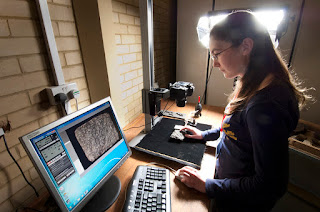 |
A volunteer positions a specimen and fires the shutter
by using a remote computer controlled ‘live-view’ image (EOS Utility software) |
After capturing and completing the 220,000 images of the Scottish Sliced Rock Collection project the volunteers were eager for something new and different. A new project is now underway in Murchison House, Edinburgh, as volunteers begin work photographing the British Geological Survey’s extensive rock hand specimen collections.
The collections include over 150,000 samples, so this is no small task, but definitely an interesting one. The Murchison House rock collections date back over 100 years, with the first Scottish rock sample registered in 1900 – a lump of basalt from Arthur’s Seat. Over the century, the Survey rock collection has been added to by specimens from Survey field mapping, university donations, samples from geological studies and personal collections.
There are five main sub-collections: the Scottish Sliced Rock collection, the Murchison Collection, the Edinburgh Collection, the Edinburgh Museum Collection and the Systematic Collection. We are tackling the last one, the Systematic Collection first as it has only 15,000 specimens, it is a small collection with high quality and nicely shaped specimens, and because it has ‘systematic’ coverage for Scotland Scotland
 |
| Lower Sill, Foundation of Museum at City Wall, 1912 |
As these rock samples were gathered they were individually hand-trimmed and shaped for display purposes, and to reflect the most geologically interesting aspects of each. With such large numbers being trimmed by hand perhaps it represents a great deal of Edwardian repetitive strain injury!
The actual process of photographing the samples is just the initial step. Once this is completed, the image quality must be enhanced. The background is selected and a uniform black fill is applied, a scale bar needs to be added and the colour must be adjusted to the greyscale indicator which was added at the photography stage. These enhancements are undertaken in Photoshop. Thankfully a full step-by-step guide is provided for volunteers who aren’t Photoshop-savvy and who are learning the software.
A parallel metadata capture programme is also in operation to capture details of the rocks such as their type and location. This work involves meticulous transcription from old hand-written registers into a database. Grid References are also being worked out for a GIS approach to finding specimens.
 |
| “Curly” Broxburn Shale, Westwood |
Technological inexperience aside, amenable working conditions at Murchison House allow for happy reflection on the labels adorning rock samples, some of which are fascinating, informing the reader of the terrible weather conditions when the sample was collected. Most volunteers are also geologists undertaking fieldwork in Scotland . These labels evoke sympathy for the original collector. There’s nothing like reading about horizontal sleet, swamps and biting flies to make volunteers feel cosy at their desks or in front of the camera in the warm studio.
The results of the project will be made available to the public via the BGS Britrocks application and also on Geoscenic, the BGS web-based image service.
Rachel Whitty, BGS volunteer


Comments